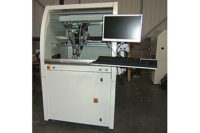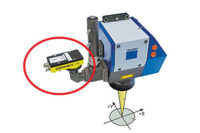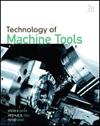Assembly In Action: New Calibration Method Improves Accuracy of Machine Tools
Northrop
Grumman Corp. has been one of the largest suppliers to the U.S. military for
many years. Recently, the company sought a way to achieve higher accuracies on large-volume
machine tools used to produce the F-35 Joint Strike Fighter.

Accuracy is very important to both the U.S. military and its contract suppliers-and not just on the battlefield.
Northrop Grumman Corp. has been one of the largest suppliers to the U.S. military for many years.
Recently, the company sought a way to achieve higher accuracies on large-volume machine tools used to produce the F-35 Joint Strike Fighter. This past June, Northrop Grumman successfully deployed an innovative process that establishes a new methodology in volumetric error compensation for large machine tools.
Known as volumetric error compensation (VEC), it was developed by Automated Precision Inc. at the start of 2010 as part of API’s pioneering efforts in volumetric accuracy for large machine tools (VALMT). These VALMT efforts were soon recognized with a Defense Manufacturing Excellence Award from the National Center for Advanced Technologies.
VEC differs from traditional methods of machine tool calibration, which involves measuring each element of travel, one at a time to determine the compensation factors necessary for each of the 21 error parameters (for a three-axis machine). To significantly improve the volumetric accuracy and process capability of a three- to six-axis machine tool, VEC technology continuously takes measurements with a laser tracker from a single set up. Then highly advanced algorithms process the data within minutes.
“VEC improved our machine tool performance considerably,” says Wayne Bromiley, a Northrop Grumman facilities engineer. “It reduced the calibration times from one week of 12- and 14-hour days down to one eight-hour shift. This saved us a major amount of down time and made the machines more available for production use.”
Extensive on-machine testing at Northrop Grumman’s Palmdale, CA, facility has shown that VEC improved accuracy by 31.6 percent. Northrop Grumman’s 120-hole step-pattern drilling test went from 100 percent failure before VEC to having 100 percent passing with only three holes being above ideal tolerance but still within allowable error.
The Boeing Co., another military contract supplier, is equally impressed with VEC. “This process will dramatically reduce assembly and fitting costs, which represent up to one percent of the total cost per aircraft,” says Sam Easley, engineer and scientist. “On large programs like the F-18 or the 700 aircraft series, we could save $100 million per year.”
Faris Ibrahim, mechanical engineer for the Naval Foundry and Propeller Center, says the process “has the potential to save the U.S. Navy money and shave valuable time off of vessel construction costs, putting assets where they are most needed, with the war fighter.”
The National Center for Manufacturing Sciences’ vice president Chuck Ryan agrees, saying that “The innovative VALMT project will save the Department of Defense millions while ensuring weapon systems are mission ready and available for our war fighters when they need them. This technology will also pave the way for reducing the manufacturing costs of commercial ships and aircraft, benefitting both government and industry.”
For more information on machine tool accuracy, call 800-537-2720 or visit www.apisensor.com.

Northrop
Grumman Corp. has used VEC technology to achieve higher accuracies on
large-volume machine tools used to produce the F-35 Joint Strike Fighter. Photo
courtesy Automated Precision Inc.
Accuracy is very important to both the U.S. military and its contract suppliers-and not just on the battlefield.
Northrop Grumman Corp. has been one of the largest suppliers to the U.S. military for many years.
Recently, the company sought a way to achieve higher accuracies on large-volume machine tools used to produce the F-35 Joint Strike Fighter. This past June, Northrop Grumman successfully deployed an innovative process that establishes a new methodology in volumetric error compensation for large machine tools.
Known as volumetric error compensation (VEC), it was developed by Automated Precision Inc. at the start of 2010 as part of API’s pioneering efforts in volumetric accuracy for large machine tools (VALMT). These VALMT efforts were soon recognized with a Defense Manufacturing Excellence Award from the National Center for Advanced Technologies.
VEC differs from traditional methods of machine tool calibration, which involves measuring each element of travel, one at a time to determine the compensation factors necessary for each of the 21 error parameters (for a three-axis machine). To significantly improve the volumetric accuracy and process capability of a three- to six-axis machine tool, VEC technology continuously takes measurements with a laser tracker from a single set up. Then highly advanced algorithms process the data within minutes.
“VEC improved our machine tool performance considerably,” says Wayne Bromiley, a Northrop Grumman facilities engineer. “It reduced the calibration times from one week of 12- and 14-hour days down to one eight-hour shift. This saved us a major amount of down time and made the machines more available for production use.”
Extensive on-machine testing at Northrop Grumman’s Palmdale, CA, facility has shown that VEC improved accuracy by 31.6 percent. Northrop Grumman’s 120-hole step-pattern drilling test went from 100 percent failure before VEC to having 100 percent passing with only three holes being above ideal tolerance but still within allowable error.
The Boeing Co., another military contract supplier, is equally impressed with VEC. “This process will dramatically reduce assembly and fitting costs, which represent up to one percent of the total cost per aircraft,” says Sam Easley, engineer and scientist. “On large programs like the F-18 or the 700 aircraft series, we could save $100 million per year.”
Faris Ibrahim, mechanical engineer for the Naval Foundry and Propeller Center, says the process “has the potential to save the U.S. Navy money and shave valuable time off of vessel construction costs, putting assets where they are most needed, with the war fighter.”
The National Center for Manufacturing Sciences’ vice president Chuck Ryan agrees, saying that “The innovative VALMT project will save the Department of Defense millions while ensuring weapon systems are mission ready and available for our war fighters when they need them. This technology will also pave the way for reducing the manufacturing costs of commercial ships and aircraft, benefitting both government and industry.”
For more information on machine tool accuracy, call 800-537-2720 or visit www.apisensor.com.
Looking for a reprint of this article?
From high-res PDFs to custom plaques, order your copy today!








